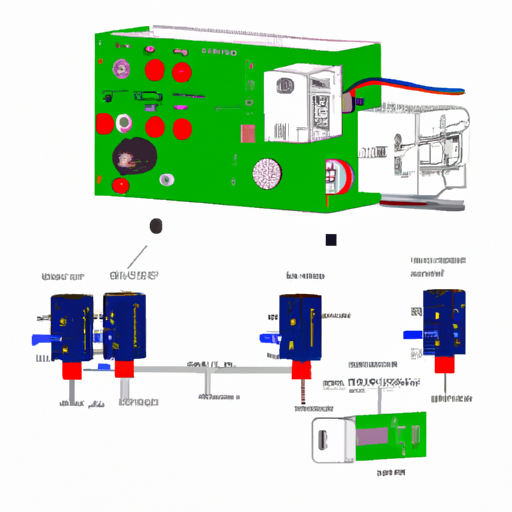

Title: Exploring the Diverse Product Types of Power Relays

1. Electromechanical Relays (200 words) Electromechanical relays are the most common type of power relays. They consist of a coil, an armature, and a set of contacts. When the coil is energized, it creates a magnetic field that attracts the armature, causing the contacts to close or open. These relays are known for their reliability, durability, and ability to handle high currents and voltages. They are widely used in applications such as motor control, lighting systems, and power distribution.
2. Solid-State Relays (200 words) Solid-state relays (SSRs) are semiconductor devices that use electronic components, such as transistors and thyristors, to perform the switching operation. Unlike electromechanical relays, SSRs have no moving parts, making them more reliable, faster, and quieter. They are commonly used in applications where silent operation, high switching speeds, and long lifespan are crucial, such as in medical equipment, HVAC systems, and industrial machinery.
3. Reed Relays (200 words) Reed relays are unique in their design, utilizing a hermetically sealed glass tube containing two metal reeds and a coil. When the coil is energized, the magnetic field causes the reeds to come into contact, completing the circuit. Reed relays are known for their compact size, low power consumption, and excellent isolation properties. They find applications in telecommunications, test and measurement equipment, and security systems.
4. Mercury Wetted Relays (200 words) Mercury wetted relays are specialized relays that use a pool of mercury to make and break electrical connections. These relays offer extremely low contact resistance, high reliability, and excellent performance in high-frequency applications. However, due to environmental concerns associated with mercury, their usage has significantly decreased in recent years. They are still found in specific applications such as aerospace, military, and high-frequency signal switching.
5. Latching Relays (200 words) Latching relays, also known as bistable relays, maintain their state even after the power is removed. They require a pulse of current to change their state, either from normally open to normally closed or vice versa. Latching relays are commonly used in applications where power consumption is a concern, such as battery-powered devices, energy management systems, and telecommunications.
Conclusion (100 words) Power relays are versatile components that play a crucial role in controlling electrical circuits. This article has explored the various product types of power relays, including electromechanical relays, solid-state relays, reed relays, mercury wetted relays, and latching relays. Each type offers unique features and advantages, making them suitable for specific applications across different industries. By understanding the diverse range of power relays available, engineers and designers can make informed decisions when selecting the most appropriate relay for their specific requirements.
Title: Exploring the Diverse Product Types of Power Relays

1. Electromechanical Relays (200 words) Electromechanical relays are the most common type of power relays. They consist of a coil, an armature, and a set of contacts. When the coil is energized, it creates a magnetic field that attracts the armature, causing the contacts to close or open. These relays are known for their reliability, durability, and ability to handle high currents and voltages. They are widely used in applications such as motor control, lighting systems, and power distribution.
2. Solid-State Relays (200 words) Solid-state relays (SSRs) are semiconductor devices that use electronic components, such as transistors and thyristors, to perform the switching operation. Unlike electromechanical relays, SSRs have no moving parts, making them more reliable, faster, and quieter. They are commonly used in applications where silent operation, high switching speeds, and long lifespan are crucial, such as in medical equipment, HVAC systems, and industrial machinery.
3. Reed Relays (200 words) Reed relays are unique in their design, utilizing a hermetically sealed glass tube containing two metal reeds and a coil. When the coil is energized, the magnetic field causes the reeds to come into contact, completing the circuit. Reed relays are known for their compact size, low power consumption, and excellent isolation properties. They find applications in telecommunications, test and measurement equipment, and security systems.
4. Mercury Wetted Relays (200 words) Mercury wetted relays are specialized relays that use a pool of mercury to make and break electrical connections. These relays offer extremely low contact resistance, high reliability, and excellent performance in high-frequency applications. However, due to environmental concerns associated with mercury, their usage has significantly decreased in recent years. They are still found in specific applications such as aerospace, military, and high-frequency signal switching.
5. Latching Relays (200 words) Latching relays, also known as bistable relays, maintain their state even after the power is removed. They require a pulse of current to change their state, either from normally open to normally closed or vice versa. Latching relays are commonly used in applications where power consumption is a concern, such as battery-powered devices, energy management systems, and telecommunications.
Conclusion (100 words) Power relays are versatile components that play a crucial role in controlling electrical circuits. This article has explored the various product types of power relays, including electromechanical relays, solid-state relays, reed relays, mercury wetted relays, and latching relays. Each type offers unique features and advantages, making them suitable for specific applications across different industries. By understanding the diverse range of power relays available, engineers and designers can make informed decisions when selecting the most appropriate relay for their specific requirements.